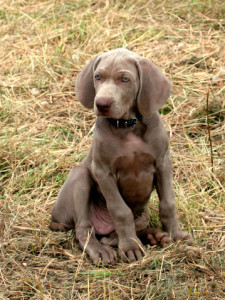 Description The Weimaraner is a sleek, moderately large, athletic dog with beautiful lines. It comes in a short, fine, smooth gray coat or a rarer longhaired variety (FCI Group 7). All shades of gray are accepted. The head and ears are a bit lighter in color than the rest of the body. The head is long and aristocratic and the muzzle is strong. The eyes are amber, blue-gray or gray – with an intelligent expression, and the nose is gray. The ears are moderately long and pendant. The topline slopes gently downward from the withers. The forelegs should be straight with dewclaws removed. The tail is docked to 1 inches (4cm) when the dog is two days old. The limbs are long and muscular. The Weimaraner has webbed feet for swimming.
Description The Weimaraner is a sleek, moderately large, athletic dog with beautiful lines. It comes in a short, fine, smooth gray coat or a rarer longhaired variety (FCI Group 7). All shades of gray are accepted. The head and ears are a bit lighter in color than the rest of the body. The head is long and aristocratic and the muzzle is strong. The eyes are amber, blue-gray or gray – with an intelligent expression, and the nose is gray. The ears are moderately long and pendant. The topline slopes gently downward from the withers. The forelegs should be straight with dewclaws removed. The tail is docked to 1 inches (4cm) when the dog is two days old. The limbs are long and muscular. The Weimaraner has webbed feet for swimming.
 Temperament Weims are happy, loving, intelligent, cheerful, and affectionate. Without the proper exercise they will be very rambunctious. This breed needs firm, experienced training from the start, with an owner who understands how to be a dog’s pack leader, or this breed can become highly opinionated and willful. Without this proper leadership, they can become combative with other dogs. Quick to learn, but resistant to repetitive training. Can bereserved with strangers. Socialize them well at an early age. Protective on his own territory. Very brave and loyal, it has a strong prey instinct. Do not trust with small non-canine animals. This is definitely not a herding or farm dog. The Weimaraner needs to live indoors as a member of the family. He needs attention and companionship, but most of all, leadership, boundaries he needs to follow, and limitations to what he his allowed to do, along with consistent leadership. These things are instinctually essential to having a happy, behaved, stable minded dog. If regulated to a kennel life or if left alone too much, he can become very destructive and restless. He is a natural protector. Weimaraners are often kind to children, but are not recommended for very young ones, because they are energetic enough to accidentally knock a child down.
Temperament Weims are happy, loving, intelligent, cheerful, and affectionate. Without the proper exercise they will be very rambunctious. This breed needs firm, experienced training from the start, with an owner who understands how to be a dog’s pack leader, or this breed can become highly opinionated and willful. Without this proper leadership, they can become combative with other dogs. Quick to learn, but resistant to repetitive training. Can bereserved with strangers. Socialize them well at an early age. Protective on his own territory. Very brave and loyal, it has a strong prey instinct. Do not trust with small non-canine animals. This is definitely not a herding or farm dog. The Weimaraner needs to live indoors as a member of the family. He needs attention and companionship, but most of all, leadership, boundaries he needs to follow, and limitations to what he his allowed to do, along with consistent leadership. These things are instinctually essential to having a happy, behaved, stable minded dog. If regulated to a kennel life or if left alone too much, he can become very destructive and restless. He is a natural protector. Weimaraners are often kind to children, but are not recommended for very young ones, because they are energetic enough to accidentally knock a child down.
Give your Weim plenty of extensive exercise, or he will become very restless and over excited. Because this breed is so full of energy, the first thing they need to learn is sit, then praise only when sitting. This will prevent jumping in the future, as they are strong dogs and will knock over elderly or children by accident.
This breed especially should not be hit to discipline, they become wary easily. Once they have a fear of someone/something, they look to avoid and training is all but impossible. They are so eager to please, and motivated by reward (food or praise) Once a trick is learned, the dog will leap to repeat for praise. Although they are often mistaken as dumb, because they have such focus, if the trick or owners request isn’t their focus at the time, it will not occur!
Spend a lot of time with short leash walk, next to you. If left to run ahead they will pull like a train. A loose prong collar, making sure the chain section is in the front, and only pull forward and down, with a quick release when walking. Do not use choke or prong to train, they become hopeless very quick and all is lost from this point.
This breed likes to bark, and needs to be corrected if it becomes excessive. Very hardy, with a good sense of smell, and a passionate worker, the Weimaraner can be used for all kinds of hunting.
Height, Weight Height: Dogs 24-27 inches (61-69cm) Bitches 22-25 inches (56-63cm) Weight: Dogs 55-70 pounds (25-32kg) Bitches 50-65 pounds (23-29kg)

Health Problems As they are prone to bloat, it is better to feed them two or three small meals a day rather than one large meal. They may also suffer from hip dysplasia, but are in general a hardy breed of dog. Hip dysplasia has been reduced to only 8% through conscientious breeding. Prone to hypertropic osteodystro (too rapid growth) and tumors.
Living Conditions Weimaraners will do okay in an apartment if it is sufficiently exercised. They are relatively inactive indoors and will do best with at least a large yard.
Exercise: These are powerful working dogs with great stamina. They need to be taken for a daily, long walk or jog. In addition, they need plenty of opportunities to run free. Do not exercise them after meals. It is best to feed a dog after a long walk, as soon as they cool down.
Life Expectancy: About 10-12 years.
Grooming: The smooth, short-haired coat is easy to keep in peak condition. Brush with a firm bristle brush, and dry shampoo occasionally. Bathe in mild soap only when necessary. A rub over with a chamois will make the coat gleam. Inspect the feet and mouth for damage after work or exercise sessions. Keep the nails trimmed. This breed is an average shedder.
Origin The breed is several centuries old. A Weimaraner appeared in a Van Dyck painting of the early 1600’s. There are various theories as to its origin. Some feel it is the result of albinism that overtook some ancient German pointing dogs. Others feel it is descended from the German hound, the Braken. And still others feel it is the fruit of crossings overseen by Grand Duke Karl August of Weimar between a regular pointer and a certain yellow pointer. The Weimaraner is a pointer and an all-around personal hunting dog. He was originally used to hunt, track and bring down big game. As big game became scarce, he was adapted to smaller game and upland birds. He also has a reputation as a fine water retriever, though he may need to be taught to swim. Weimaraners have been used as rescue dogs, service dogs for the disabled, and as police dogs in England and Germany. The breed was first imported to the United States in 1929 by Howard Knight who founded the U.S. breed club. Sesame Street often plays skits with this breed dressed up in human clothes. Some of its talents include: hunting, tracking, retrieving, pointing, watchdogging, guarding, police work, search & rescue, and agility.
